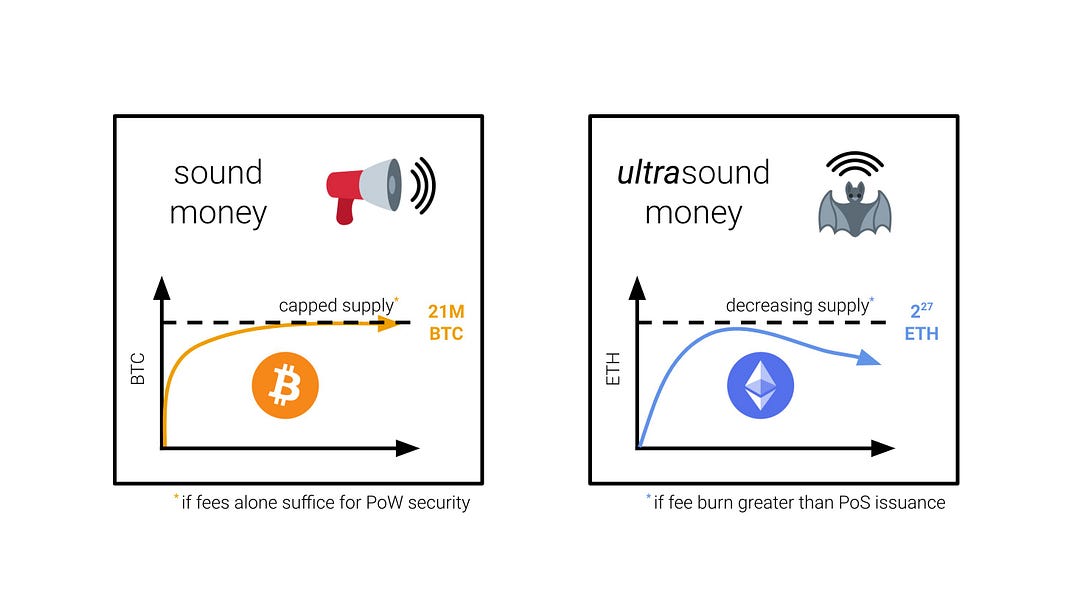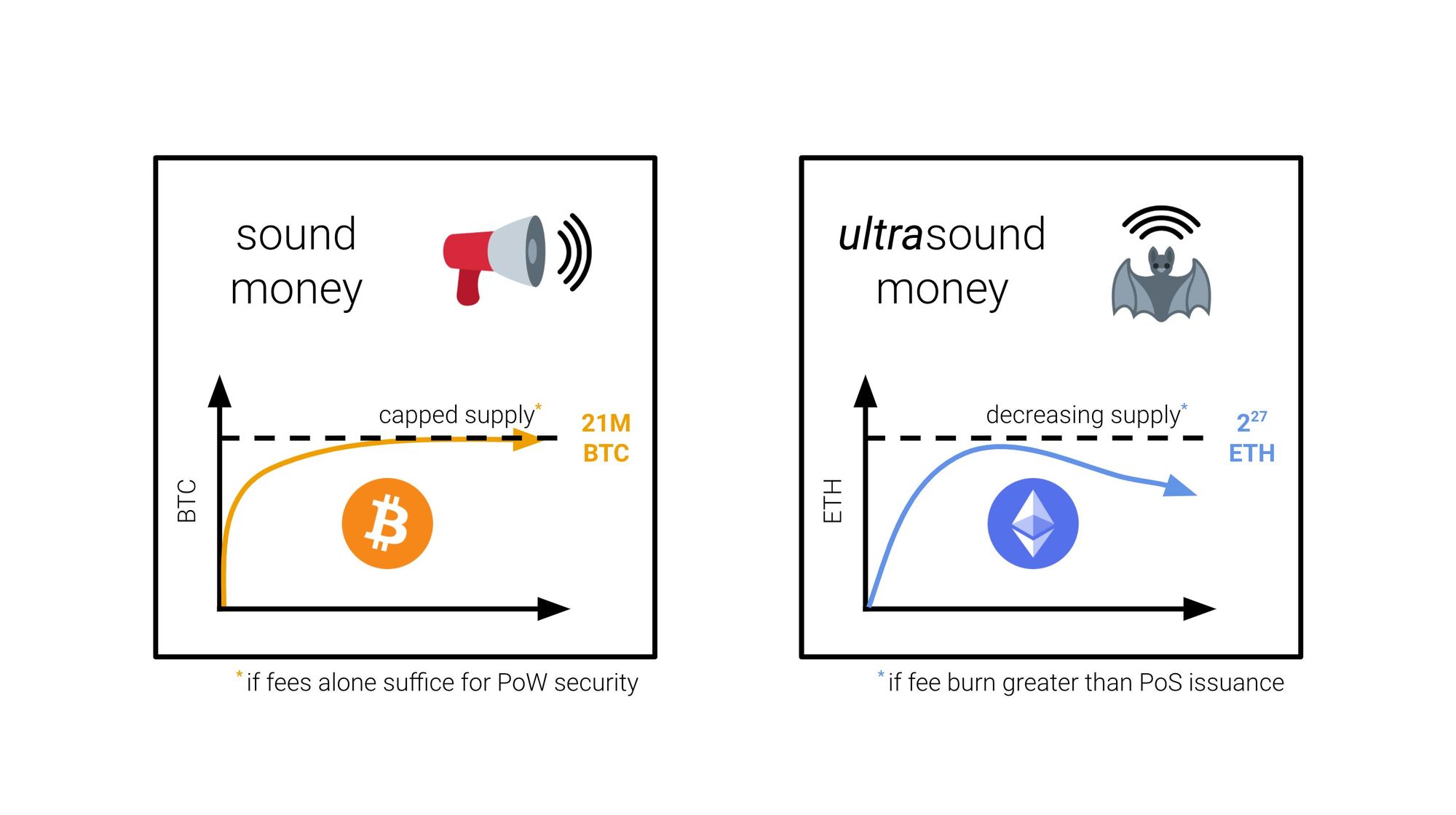ETH is Ultra Sound Money

Dear Bankless Nation,
Next week, Justin Drake will join us on the Bankless podcast for an epic 2.5-hour saga on how ETH is Ultra Sound Money.
To prepare the Bankless Nation for this podcast, I’ve written a short summary of the Ultra Sound Money Thesis for today’s Market Monday. This will help get you prepared for the full podcast 🚀
The crypto-industry runs on narratives, and I truly believe this episode will change the narrative around ETH forever.
Let’s change the world!
- David
Crypto-Economics
Our industry is supported by two key breakthroughs:
- Cryptography (Part 1: Moon Math: the Bull Case for Cryptography)
- Economics (Part 2: Ultra Sound Money next Monday!)
A good crypto-economic system optimizes both cryptography and economics.
The Ethereum researchers have gone through an epic research and development phase to maximally optimize both its applied cryptography and its internal economics. We call this effort “Ethereum 2.0”.
Crypto-economic systems are integrated systems that can both be optimized in isolation. ‘Cryptography’ is the domain of engine design, and ‘economics’ is the domain of fuel optimization.
ETH is the fuel that powers the Ethereum economic engine.
Ethereum needs to be a sustainable crypto-economic protocol that we can pass down to our kids, and to our kid’s kids, and so on. In order to do this, Ethereum needs to be maximally efficient with the resources at its disposal. The entire design effort around ETH 2 is to enable Ethereum to create a maximally secure platform with the minimum necessary resource expenditure necessary to maximize longevity and sustainability.
As a result of this, ETH the asset has been optimized for soundness.
Maximizing Ethereum security requires optimizing for the soundness of ETH. You can’t maximally protect Ethereum without also maximizing the moneyness of ETH.
When both the engine and its fuel are maximally optimized, the economic engine can move mountains.
ETH’s Crypto Economic Optimizations
Proof of Stake (PoS)
Proof of Stake allows for orders of magnitude more security than Proof of Work.
PoW secures a chain by incentivizing hardware miners to consume as much electricity as possible, at the lowest cost possible. The mining entity that can consume more electricity than others generally wins the PoW race and generates the most profit.
This is extremely resource-consumptive. All the value of the electricity that miners pay goes into the selling-pressure of the PoW asset. Because the cost of security for PoW chains is designed to be as high as possible, this ultimately causes significant long-term net-selling pressure on the asset that miners generate revenue from.
Inefficient consensus engines can’t provide the same level of security at the same dollar costs. Efficient consensus engines create less net-selling pressure on the asset, making the asset more sound. Efficient consensus engines don’t have ‘selling’ baked into the native value of the asset.
Proof of Stake doesn’t have large consumption costs; just an internet connection, and $50-$150 in electricity usage per year. These costs are negligible. As a result, stakers don’t need to sell the asset they receive rewards in as they have minimal costs.
Because stakers don’t have large operational costs, PoS engines don’t need to consume as much energy to provide security. This is how Ethereum significantly reduces its issuance with ETH2.
Ethereum 2.0 can achieve the same level of security while issuing less ETH to do so. This makes ETH more sound.
EIP 1559
In the same vein as PoS, EIP1559 makes ETH more sound by reducing the need to issue ETH to power Ethereum’s economic engine. EIP 1559 captures excess transaction fees and returns the captured value back into ETH.
There are two ways to inject fuel into a consensus engine:
- Transaction fees
- Issuance
Transaction fees are nice because they’re free (from the perspective of the protocol). The protocol doesn’t need to mint new currency to pay for security if there is sufficient revenue from transaction fees.
The bad side of transaction fees is that they’re volatile. Sometimes they're high, sometimes they're low. They’re completely unpredictable, and unpredictable transaction fees lead to unpredictable levels of security for the system.
On the other hand, issuance is fully predictable. Issuance is baked into the protocol, which is how security can be given strong guarantees.
Predictable security is sustainable security—especially when we extrapolate years into the future. Security predictability is a requirement for a system that we intend to pass down to our kids.
The bad side of issuance is that it’s dilutive. It’s stealing power from the rest of the supply, in order to mint new coin to pay for security.
When a protocol mints new coin, it is borrowing monetary power (the fuel that powers crypto-economics) from the rest of the supply. Too much borrowing from the money supply leads to inflation and devaluation, which results in the loss of money-ness!
EIP 1559 is how we get the best of both worlds
Burned transaction fees in EIP 1559 is the un-issuance of ETH. The ‘un-issuance’ of ETH will be volatile and unpredictable, but that unpredictability is fine because Ethereum secures itself with predictable issuance instead.
It’s one thing if transaction fees are high enough to provide sufficient security for the system. But those transaction fees also need to provide sufficient security, at all times.
So, instead of paying security providers with volatile transaction fees, ETH holders pay for security with issuance and pockets the transaction fees it collects. Stable, slow issuance in the front; volatile transaction fees in the back.
Most importantly, this allows Ethereum to only issue what is necessary to achieve security.
While it’s likely that ETH issuance will still dwarf transaction fee burning at the genesis of EIP 1559 introduction, what about after Proof-of-Stake eliminates the 2 ETH / Block issuance from the PoW ETH 1 chain? What happens when burned transaction fees outpace ETH issuance?
ETH goes from an inflationary asset to a deflationary asset.
This seems like the logical choice for optimal security budget management. Why do we immediately hand over transaction fees to the security providers? Why not pay a flat rate for the security you need, and no more, while pocketing the excess revenue?
When transaction fees spike, EIP1559 allows this spike to be capture and stored for later, rather than the acute massive security overpayment. Burning ETH during times of high transaction fee revenue means that Ethereum is safe to issue more ETH in the future if it ever has a period of low or insufficient transaction fees.
If Ethereum truly becomes the value layer of the internet, then the GDP of Ethereum will perpetually march closer to being the same thing as the GDP of the Earth. Ethereum block space will always become more and more in demand, and the ETH furnace will only get hotter and hotter.
Ethereum is an Economic Engine
…and ETH is the fuel that runs that engine.
Fuel comes in all different kinds of grades, but not all fuel is created equal.
In crypto-economics, fuel is money. Blockchains are powered by money and not all monies have the same quality. Good quality money can push a crypto-economic engine further, while consuming less of it. The more ‘moneyness’ something has, the better fuel it is.
But also, the more efficient the engine, the further it can go using the same amount of fuel! Some engines are efficient, while others are inefficient. Some are gas-guzzlers, while others have been refined and optimized.
The Ethereum researchers are engine designers. They are building an integrated system of moving parts and trying to build this system in the most logical and efficient way possible.
In addition to engine design, they are also fuel optimizers, as the Ethereum monetary policy determines the grade of the fuel that they are able to put into the engine.
In crypto-economics, fuel design can be optimized just as much as engine design.
Ultra Sound Money
If Bitcoin is sound money, then Ether is Ultra Sound money
- Justin Drake
Bitcoin is optimized to be most like gold, because that’s the historical analogy that is most accessible for people to understand what is ‘Sound Money’.
But Justin Drake thinks (and I agree!) that we are using the crypto-economic revolution in technology to produce something skeuomorphic: new technology trying to express old economics.
What about the design space of new technology learning to optimize for new economics? What if we tried to create the world’s most optimized money?

Ethereum and Ether are the embodiment of doing new things in new ways, rather than doing old things in new ways.
Justin Drake called Bitcoin ‘Skeuomorphic’ in the podcast, as it was using all this new revolutionary advancement in technology, to produce something that emulated as old as Gold.
I’m glad we have that experiment: maximizing something we know already works. But there’s an equal-and-opposite strategy to find ways to maximally express the power of crypto-economic technology.
And that is what we are going to explore on the Bankless Podcast next week (Bankless Premium members get this episode tomorrow on the Premium Feed).
-David